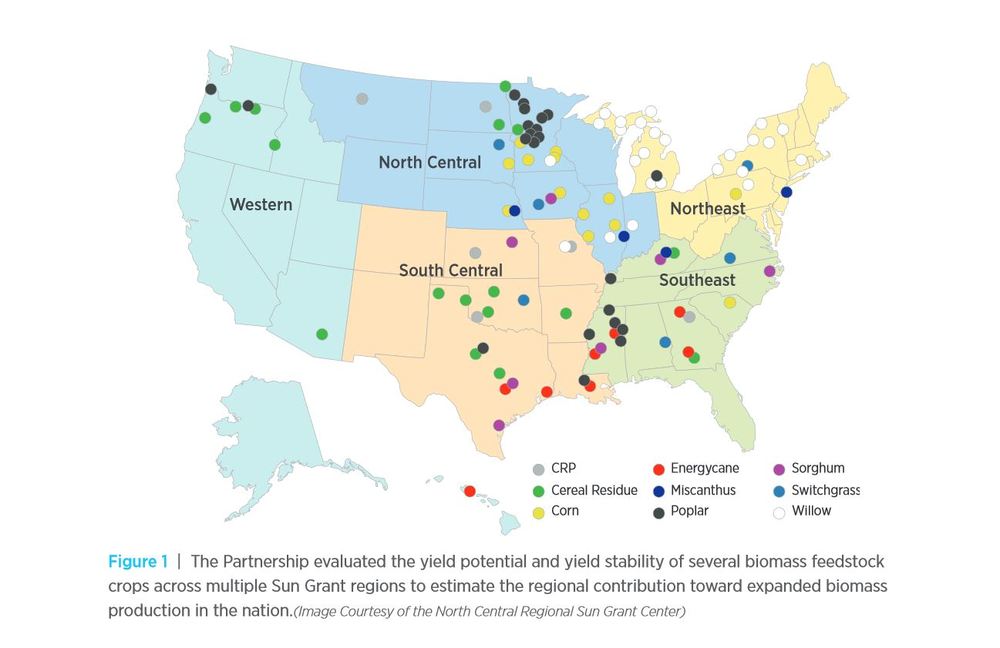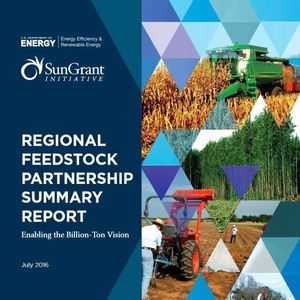Regional Feedstock Partnership report summarizes 7 years of work



Regional Feedstock Partnership
December 21, 2016
BY Katie Fletcher
The Regional Feedstock Partnership—a collaboration of the U.S. DOE, USDA, land-grant universities and industry—published a report this month to summarize its strides from 2008 to 2014 toward addressing issues associated with the development of a sustainable and projectable supply of feedstocks in the U.S. The work of the partnership is to help quantify future biomass potential.
According to the DOE, the report, entitled, Regional Feedstock Partnership Summary Report: Enabling the Billion-Ton Vision, captures progress made in validating assumptions regarding crop yields in the initial 2005 billion-ton study, informing and revising the assumptions in later iterations, including the 2016 Billion-Ton Report released this past July, as well as advancing biomass feedstock research and development.
Validating this knowledge base is essential, the report emphasized, because significant investment is required to develop and expand bioenergy crops and agricultural residues to bring them to a commercial-scale market, and to build the necessary refineries and other facilities that will convert these crops into energy, fuel and other useful products. “Because of the information gained through the partnership, many of the projects set forth in the Billion-Ton Study that were once thought by many to be overly optimistic are being shown to be reasonably realistic,” the report cited.
The summary report covers nine different energy crops within the five Sun Grant regions (Northeast, North Central, Southeast, South Central and West), and contains more than 400 scientific presentations and publications produced by the partnership. The partnership also developed comprehensive national and regional yield potential estimates for all species it evaluated.
Advertisement
Advertisement
The summary report identifies some specific examples of impactful outcomes due to the efforts put forth by the regional feedstock partnership over the past seven years. It quantified specific sustainable levels of corn stover harvest for use in commercial lignocellulosic biorefineries, recommending corn stover only be removed from areas where yields of No. 2 corn grain (i.e. 15.5 percent moisture) are greater than 175 bushels per acre. Assuming this grain yield, about 50 percent of the stover harvest could be sustainable, especially if cover crops were used to provide additional protection against soil erosion the report highlighted. A case study provided in the report acknowledged that the data and results from the partnership studies support the use of corn stover as a sustainable feedstock for bioenergy production. The research group quantified that harvesting an average of 1.7 tons per acre of corn stover would increase annual nitrogen, phosphorus and potassium removal by 22, 2.4 and 28 pounds per acre, respectively.
The partnership also made advances in understanding feedstock, yield stability and crop stand persistence. The partnership demonstrated multi-year yield durability of biomass sorghum, switchgrass, miscanthus, energycane, CRP mixed perennial grasses, poplar and willow through enhanced agronomic practices and genetic evaluation, as well as validated improved yields across wide geography in new varieties/cultivars of biomass sorghum, energycane, hybrid poplar and shrub willows. Another highlighted impactful outcome in the report is the demonstration of the increased winter cold tolerance of new energycane varieties relative to sugarcane varieties.
Further, the partnership compiled a data set on feedstock quality and its relation to conversion processes and yields. The partnership concluded from the data that miscanthus and switchgrass may perform well in biochemical conversion process if the higher lignin content of these feedstocks does not decrease conversion performance.
Advertisement
Advertisement
In addition to underpinning the data found in the DOE’s billion-ton study, the partnership has supplied researchers with new data on energy crop yields for the Bioenergy Knowledge Discovery Framework, as well as BETO’s Feedstock Supply and Logistics Program.
The report is co-authored through a partnership between DOE’s Bioenergy Technologies Office, the Sun Grant Iterative and Idaho National Laboratory. The summary report, Appendix A, which details Crop/Team reports, and Appendix B, which lists publications and products created from the partnership, can be accessed here.
Related Stories
U.S. fuel ethanol capacity fell slightly in April, while biodiesel and renewable diesel capacity held steady, according to data released by the U.S. EIA on June 30. Feedstock consumption was down when compared to the previous month.
XCF Global Inc. on July 8 provided a production update on its flagship New Rise Reno facility, underscoring that the plant has successfully produced SAF, renewable diesel, and renewable naphtha during its initial ramp-up.
The U.S. EPA on July 8 hosted virtual public hearing to gather input on the agency’s recently released proposed rule to set 2026 and 2027 RFS RVOs. Members of the biofuel industry were among those to offer testimony during the event.
The USDA’s Risk Management Agency is implementing multiple changes to the Camelina pilot insurance program for the 2026 and succeeding crop years. The changes will expand coverage options and provide greater flexibility for producers.
EcoCeres Inc. has signed a multi-year agreement to supply British Airways with sustainable aviation fuel (SAF). The fuel will be produced from 100% waste-based biomass feedstock, such as used cooking oil (UCO).
Upcoming Events










